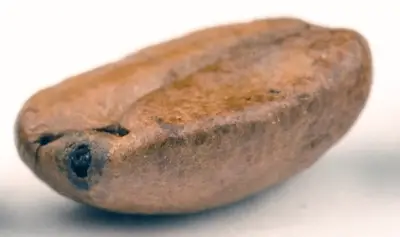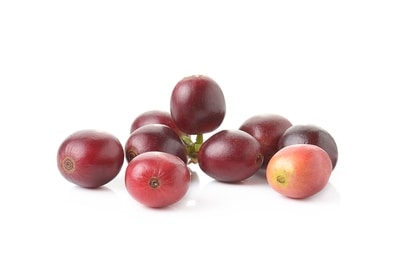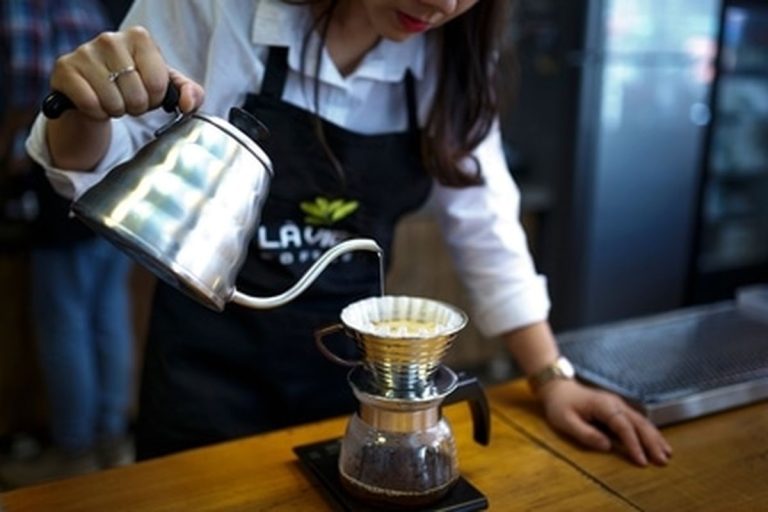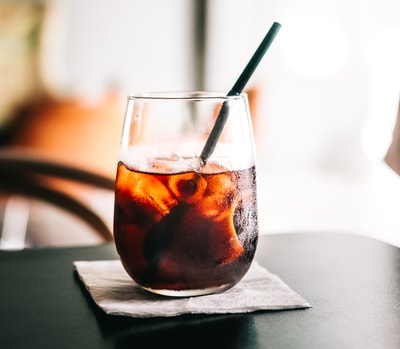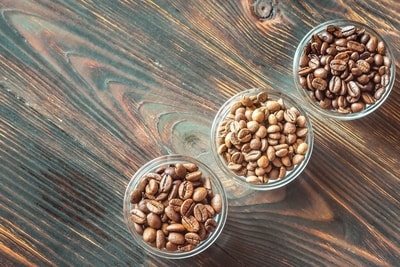How Much Caffeine Is in a Coffee Bean? (Full Breakdown)
Caffeine is the most widely consumed psychoactive substance in the world, and many of us insist on only using whole coffee beans to get our daily caffeine fix. But how much caffeine is in a coffee bean?
On average, a single arabica coffee bean contains 1.9 milligrams of caffeine (1.2 – 1.5g of caffeine per 100g). A single robusta coffee bean has 2.9 milligrams of caffeine (2.2 – 2.7g of caffeine per 100g). A 250ml (8.5fl oz) cup of arabica filter coffee contains 100 milligrams of caffeine.
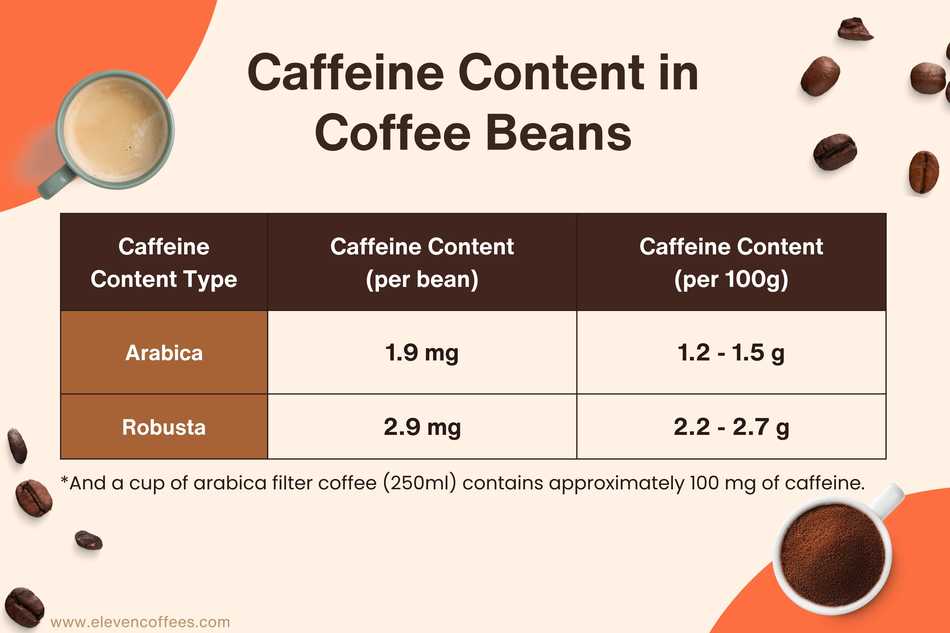
So why do caffeine levels vary so much? And what about decaf, does that contain caffeine?
Caffeine in coffee beans
Caffeine runs throughout the entire coffee plant, with the highest concentration found within the coffee beans housed inside the coffee cherry fruit.
Despite there being 100 species of coffee plant, just two varieties make up over 98 percent of the coffee grown worldwide.
These two varieties are known as Coffea arabica and Coffea canephora, better known as arabica and robusta, respectively.
Although these two varieties are the most popular coffee beans on the planet, they couldn’t be more different. One of the many differences is in the amount of caffeine that the beans contain.
A single, unroasted arabica coffee bean has 1.9 milligrams of caffeine. By dry weight, an arabica coffee bean is between 1.2 – 1.5 percent caffeine, meaning that it contains 1.2 – 1.5g of caffeine per 100g (3.5oz).[1]
A single, unroasted robusta coffee bean has 2.9 milligrams of caffeine. By dry weight, a robusta coffee bean is between 2.2 – 2.7 percent caffeine, meaning that it contains 2.2 – 2.7g of caffeine per 100g (3.5oz).[2]
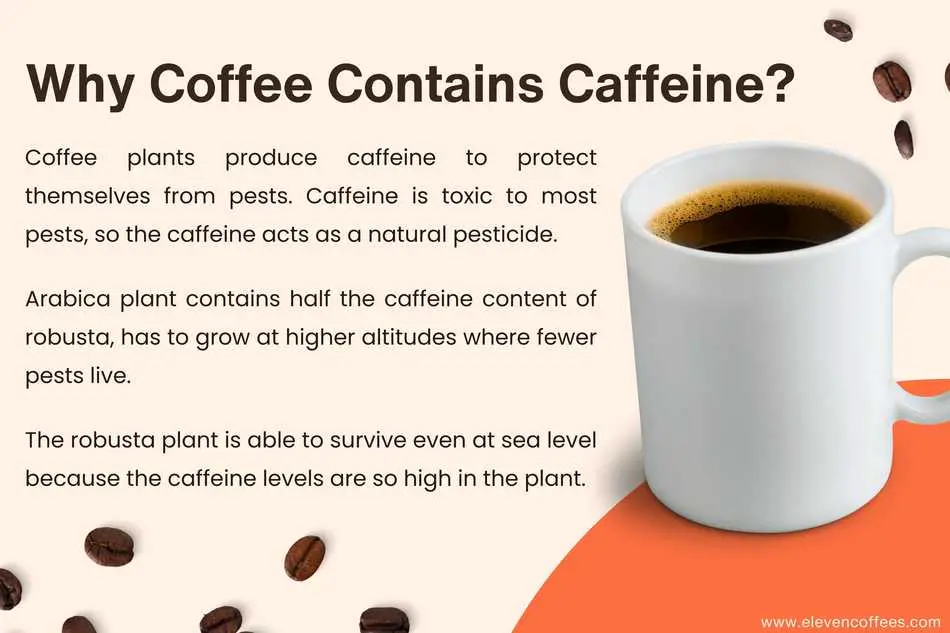
So why does coffee contain caffeine? The coffee plant contains caffeine as a means to protect itself. Caffeine is toxic to most pests, so the caffeine acts as a natural pesticide.
The arabica plant, which contains around half the caffeine content of robusta, has to grow at higher altitudes where fewer pests live.
The robusta plant is able to survive even at sea level because the caffeine levels are so high in the plant.
Does decaf contain caffeine?
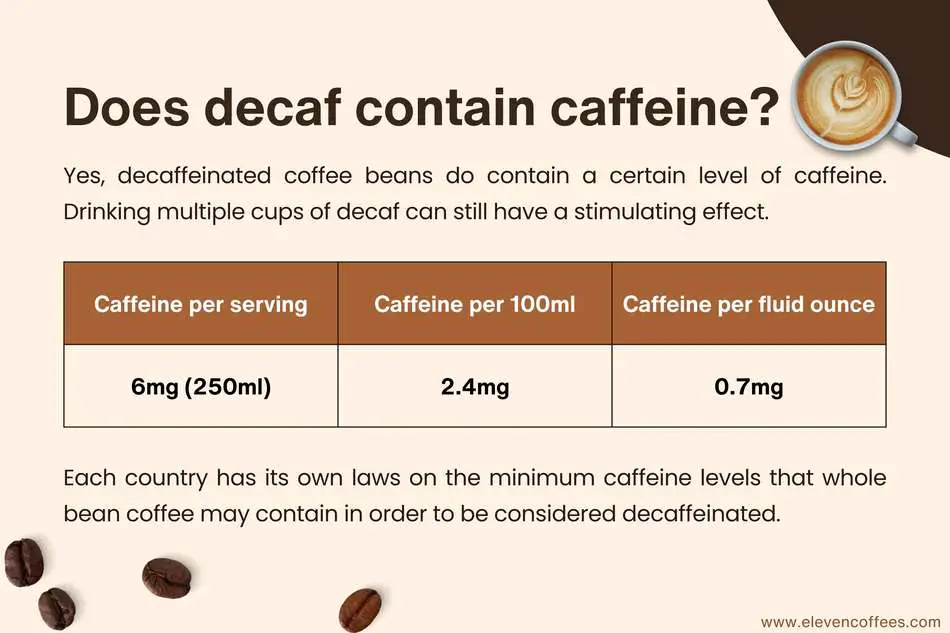
Decaffeinated coffee beans do contain a certain level of caffeine. Here is a comparison with other beverages containing caffeine.
As you can see, caution does need to be taken when drinking decaf as several cups could quickly add up to have a stimulating effect.
Each country has its own laws on the minimum caffeine levels that whole bean coffee may contain in order to be considered decaffeinated.
In the US, coffee has to have 97 percent of its caffeine content removed to be considered decaf.[3]
In Canada, the law states that decaf coffee has to be 99.7 percent caffeine-free.[4]
And under European, Australian and New Zealand law, decaf coffee has to be 99.9 percent caffeine-free.[5][6]
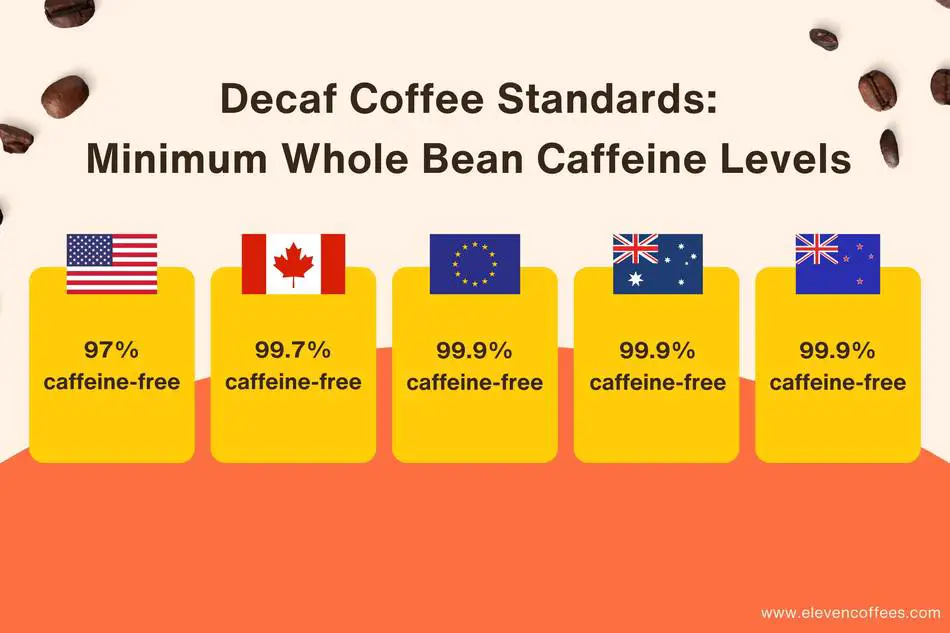
There are currently five different methods used to decaffeinate coffee, which are:
- Organic solvent process (direct)
- Organic solvent process (indirect)
- Swiss Water process
- Supercritical CO2 process
- Triglyceride process
The decaffeination process takes place before roasting when the beans are in their raw, green state.
How much caffeine is in a cup of coffee?
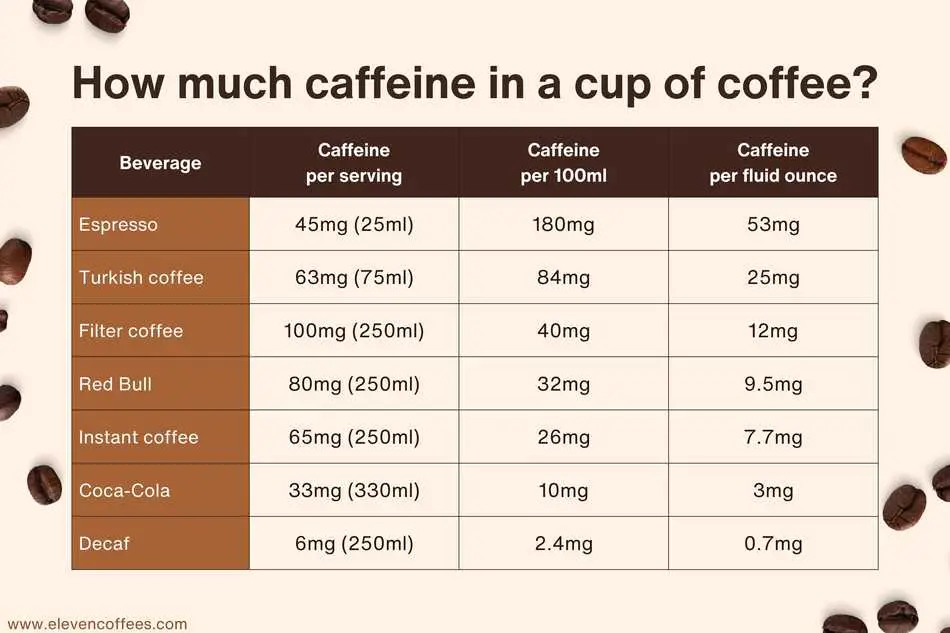
Approximately 90 percent of coffee beans’ caffeine content is estimated to extract within the first minute of brewing.[7]
To make a 250ml (8.5fl oz) cup of filter coffee, you need approximately 100 arabica coffee beans. A 250ml serving made up of 100 coffee beans provides 100mg caffeine.
The level of caffeine extracted varies depending on factors such as water temperature, brew method, brew time and grind size.
Hot water is more able to extract caffeine than cold water, which is why cold brew coffee contains less caffeine.
Do light roast or dark roast coffee beans contain more caffeine?
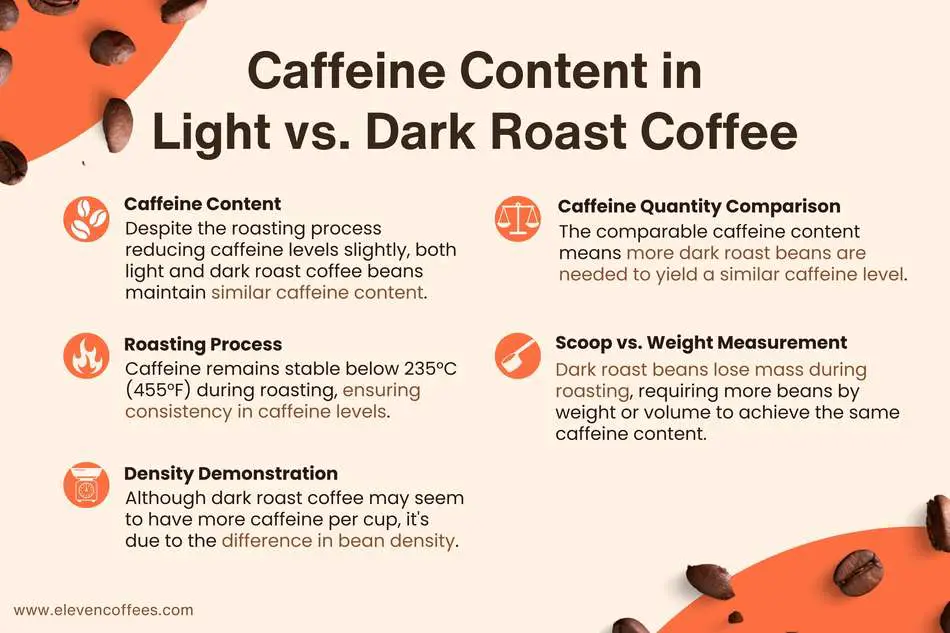
The coffee roasting process does result in the coffee beans containing a little less caffeine than the raw, green beans. One of the questions I hear most often is does dark roast coffee have more caffeine than light roast?
Light roast coffee beans contain the same amount of caffeine as dark roast coffee beans as the caffeine content remains pretty much constant throughout each stage of the roasting process.
Caffeine is stable at temperatures below 235°C (455°F), and few coffee roasters would roast a coffee past this temperature due to the risk of fire.
However, a cup of dark roast coffee will probably contain more caffeine than a cup of light roast. What? How?
It’s all to do with the density of the coffee beans. As coffee is roasted darker and darker, the beans lose mass. But despite the loss of mass, the caffeine content stays the same.
Whether you measure your coffee beans by weight using a scale or by volume using a scoop, the result is the same.
If you weigh your coffee beans, you will need more dark roast beans to match the weight because darker beans are smaller.
Similarly, if you measure your beans by volume using a scoop, you’ll require more dark roast beans to fill the scoop.
In both cases, you need more dark roast beans compared to the larger light roast beans.
Whilst this does mean you can use fewer coffee beans using a packet of dark roast for your caffeine fix, the fact is you shouldn’t as dark roast coffee is nasty. Oh, and stop using a scoop to measure your coffee, too. Don’t miss our other 50 simple tips for making better coffee.
Confusion over caffeine and bitterness
Many people often believe that dark roast coffee has more caffeine because of its increased bitterness and kick, which they associate with caffeine.
It’s true that caffeine is intensely bitter, which is why it’s often cited as the reason that coffee is bitter. However, caffeine only accounts for a fraction of the bitterness in arabica coffee.
The reason that dark roast coffee tastes so bitter is because of the chemical reactions that take place during prolonged roasting. The longer a coffee is roasted, the more that certain acids turn into bitter-tasting compounds.
You’ll notice that dark roast coffee is (almost) black. That’s because it’s essentially burned, which is why it has that harsh, ashy, bitter taste.
It’s a misnomer that all coffee is bitter, which is a shame because good-quality coffee is definitely not bitter. Read my article to find out how you can enjoy bitter-free coffee.
Enjoyed this article? Don’t miss What Is Cascara?
Naturally low caffeine coffee
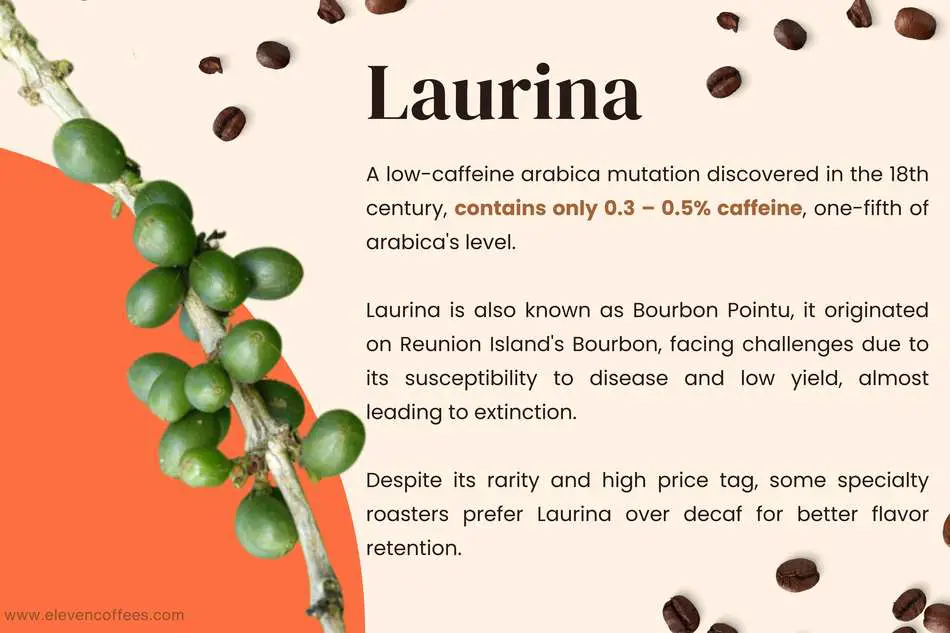
One particular variety of coffee known as laurina is naturally low in caffeine. You’ve probably never heard of it, but it’s slowly making somewhat of a comeback.
Laurina, which was originally discovered in the 18th century, is a varietal (strain) of arabica, specifically an arabica bourbon mutation.
The laurina varietal contains a tiny 0.3 – 0.5 percent caffeine content. As arabica contains 1.2 – 1.5 percent caffeine, that means laurina may contain as little as one-fifth of the caffeine content of arabica.[11]
Laurina is also known as Bourbon pointu (French, ‘pointed’) after the unique pointed shape of both its beans and the tree. Bourbon refers to its origins on Reunion Island in the Indian Ocean, which was formerly called Bourbon.
Because the plant contains so little caffeine, it’s highly susceptible to disease. The plant is also low-yielding. These two factors almost led to its extinction.
Unfortunately, it’s still in short supply, which means that it demands a hefty price tag.
Some specialty roasters prefer laurina to decaf because of the detrimental effects that the decaffeination process has on coffee’s flavour.
Why not give laurina a try. Notes, a London-based coffee roaster, is currently selling laurina on their website.

